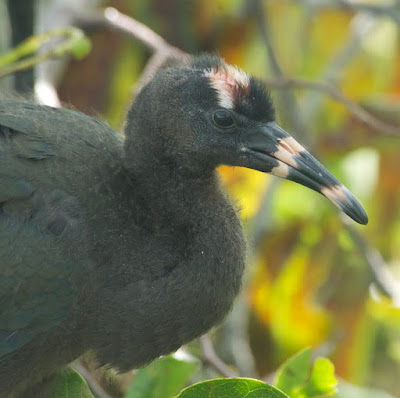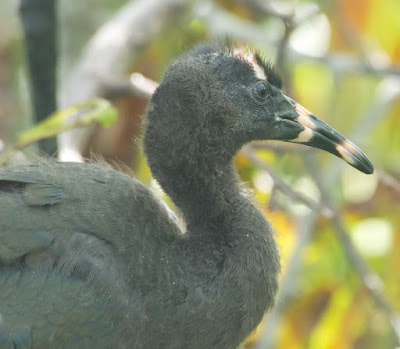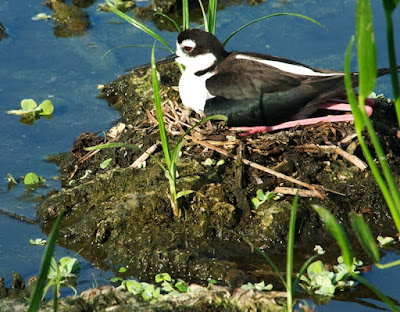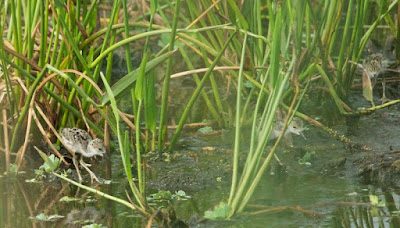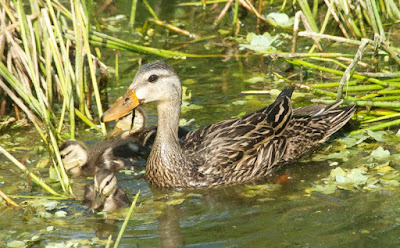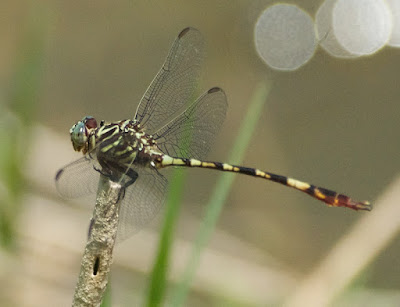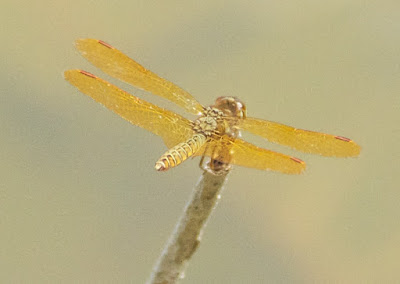On our return from Mexico in May 2014, Eileen and I found that the nesting season in South Florida was in full swing. Our morning walks around the boardwalk at Wakodahatchee Wetlands in western Delray were constantly enlivened by baby birds of all shapes and sizes growing, feeding or being fed, and exploring the world around them.
The babies ranged, at least from a human perspective, from ungainly to adorable. Definitely on the ungainly side were a brood of downy young Anhingas (Anhinga anhinga), looking quite dinosaurian (reasonably so, since birds are dinosaurs, after all).
Equally dinosaurian were these nearly-grown young Wood Storks (Mycteria americana).
Perhaps less saurian, but certainly odd-looking, were these young Glossy Ibises (Plegadis falcinellus). The parents were not at the nest when I took these photographs, and it took me a while to decide which species of ibis (out of a choice of two) these were. This plumage, with its parti-colored bill, is not in the standard field guides and I had to do a bit of digging around in my library to find a description of it.
Are these oddly-coloured head and bill markings some sort of signal to the parent bird telling it where to deposit food? Or are they an evolutionary reminiscence of the adult plumage of some long-vanished ancestor? I don't really know.
Unquestionably the most charming babies on view were the chicks of the most graceful adult birds at Wakodahatchee, the Black-necked Stilts (Himantopus mexicanus).
Aside from their delicacy and grace, stilt chicks differ from the young of ibises, storks and anhingas in that they are not nest-bound. Almost as soon as they hatch, downy young are able to explore their habitat and to find and eat food for themselves. Ornithologists have long termed baby birds of this type precocial, as opposed to the altricial young of (say) songbirds, which are nest-bound, helpless and incapable of feeding themselves until they fledge.
Ducklings, like these Mottled Duck (Anas fulvigula) chicks, are not only adorable but, like downy young stilts, entirely precocial. With a single exception, the aberrant Magpie Goose (Anseranas semipalmata) of Australia (now usually placed in its own family), no duck feeds its young; ducklings must find their own food from the day they hatch.
This is one way (of many) that ducks differ from swimming rails, including Common Gallinules (Gallinula galeata), birds that visitors to Wakodahatchee often mistake for ducks. Though downy young gallinules are able to swim for themselves, their parents continue to feed them for (depending on the species) anywhere from a few days to several weeks.
These gallinule chicks are clearly begging to be fed, their featherless wings extended in excitement as their parent approaches with breakfast.
Alongside adults and downy young gallinules were fully-fledged, independent young. Common Gallinules take forty to fifty days to reach independence, so these birds are the result of a brood that probably hatched a month to six weeks before the little birds in the previous sequence.
Purple Gallinules (Porphyrio martinicus), unlike their cousins, only feed their chicks for the first two to four days after hatching (sometimes, at least, with older juvenile "helpers" pitching in). Although these downy babies were certainly being guarded by their parent, they appeared to be finding food on their own.
Like the ibises, the baby Purple Gallinule has a remarkable multi-coloured beak. Why? A 2004 study suggests that in rails, colourful bills and other ornaments in downy young (including the bright red patches on the heads of Common Gallinule chicks) may be a response to sibling rivalry, evolving in species whose chicks compete with each other to be fed, even if only for a few days.
The most obvious nesting birds on the reserve are the various species of heron, including these nearly fully-grown Great Blue Herons (Ardea herodias).
These young Cattle Egrets (Bubulcus ibis) will probably have only a short while longer to remain in their nests, if they are not independent already.
Various Tricolored Heron (Egretta tricolor) families we're at different stages of the rearing process at the same time – obviously, their breeding cycle is somewhat staggered. Some of the chicks were still covered with down, and were obviously quite young.
Though still in down, this chick seems a bit older than the babies in the previous picture.
Heron chicks are altricial. They remain in the nest for some time, taking food from their parents and mastering the art of swallowing fish (headfirst, so the spines don't get stuck in your throat).
Juvenile Tricolored Herons, with their gaping bills and unruly topknots, remind me somehow of a gang of rebellious teenagers.
A closer look reveals birds that are even more colourful than their parents – not to mention somewhat more garish-looking...
...and with plenty of personality - a feisty next generation!
After our tour of the ruins of El Tajin (May 4, 2014), Eileen and Davin decided to take a look at a small tourist market on the edge of the site parking lot. That gave me a chance to wander around he edge of the lot see what I could turn up in the bird/insect department. I didn't have far to go before I came across a Social Flycatcher (Myiozetetes similis) attacking its reflection in a car windshield.
As I have said before, Social Flycatchers are not particularly social, and this one was downright aggressive.
Tropical America is full of tyrant flycatchers that look, more or less, like Social Flycatchers but differ in details of size, plumage and bill shape. This is the commonest (and most northerly) of them, the Great Kiskadee (Pitangus sulphuratus). 'Kiskadee' imitates the bird's ringing call (in French-speaking countries it is called 'Qu'est qu'il dit' for the same reason).
Just off the parking lot I found a young Lineated Woodpecker (Dryocopus lineatus), a tropical relative of the Pileated Woodpecker (D. pileatus) of North America. It seemed to have been not long out of the nest. Perhaps the stub it was sitting on was the best tree itself, but the vegetation around it was too thick to be worth checking (aside from disturbing the bird, the last time I had thrashed around in grassy vegetation in Mexico I had gotten a load of chigger bites for my pains).
In a corner of the lot I found a short trail that allowed me to get off-road for a few metres. On it I came across a Mexican Bluewing (Myscelia ethusa), a nymphalid butterfly that occasionally shows up in extreme south Texas burn otherwise ranges south to Colombia. It is one of a large group of mostly tropical American butterflies, the Biblidinae, many of whose adults fly to the ground to puddle or to feed on rotting fruit.
To my delight, the trail led me to a small, reed-lined pond that swarmed with dragonflies. I had only a few minutes before I had to join the others, but that was enough for me to get more or less respectable photographs of five different species. Together they formed a little community that seemed strikingly equivalent to dragonfly communities I have watched in Sarawak. Of course it would take more than a few minutes' observation to prove this notion, but the parallels were interesting.
To start with, I found a large, banded gomphid dragonfly that reminded me of the Ictinogomphus dragonflies of Asia. In this case, though, it was a male Broad-striped Forceptail (Aphylla angustifolia), so named because of the impressive sexual appendages, or cerci, at the tip of his abdomen. Forceptails as a group are purely American, and this species ranges from the Gulf Coast south to Guatemala.
The Mexican Scarlet-tail (Planiplax sanguiniventris), a handsome red-and-blue dragonfly, recalls some of the Orthetrum dragonflies of the Old World. It ranges from the Gulf Coast of Mexico (and, rarely, southern Texas) to Nicaragua. The other four species in the genus are South American, though one of them reaches Panama.
Perithemis mooma is one of the amberwings. These are smallish dragonflies, perhaps equivalent to some of the smaller Asian species. The tiniest Sarawak dragonfly, Nannophya pygmaea, is considerably smaller than this, but its female shares with amberwings a close resemblance to a wasp or biting fly. Are either, or both, mimics? P. mooma, if I have the species right here, does not reach north of Mexico (though it ranges southward into South America) and so does not seem to have a common English name.
The Roseate Skimmer (Orthemis ferruginea) is another Orthetrum lookalike (and probably closer to Orthetrum than is Planiplax, above), though I do not know of any Orthetrums that are as pink as this. It ranges from the southern United States to Brazil.
The Spot-tailed Dasher (Micrathyria aequalis) reminds me of the Asian (and Australian) Diplacodes. It belongs to a large genus of tropical American dragonflies; this one also reaches Florida and southern Texas.
The only damselfly I saw on the pond was a Mexican Wedgetail (Acanthagrion quadratum), a member of a species common in Middle America but barely crossing the US border into extreme southern Texas. Fortunately it is easy to identify (which is more than can be said for many blue-and-black dragonflies in North America): the long, slender, mostly back abdomen and the large, clearly separated occipital spots on the back if its head are distinctive field marks.
I was surprised and delighted with the little pond and its dragonflies, and would have liked to have spent a good deal longer there. However, we had a long way to go back to Veracruz City (and besides, Eileen and Davin couldn't find anything worth buying at the souvenir stalls). Our brief trip to Mexico was near its end, and I will finish with only a couple of quick photos from our drive home: a distant group of Least Grebes (Tachybaptus dominicus)...
...and basking Morelet's crocodiles (Crocodylus moreletii) in a crocodile farm. I was told that the chief reason that the Mexican government decided to hold the CITES Animals Committee meeting (my reason for being there) in Veracruz was to show off its croc farming programme. Morelet's leathers are supposedly (according to those who care about such things) superior to those of the American Crocodile (C. acutus). I will leave it up to my readers to draw any moral they may care to from this final photograph.







